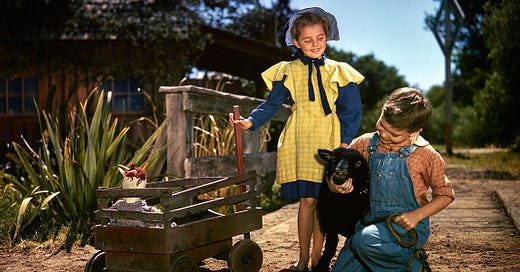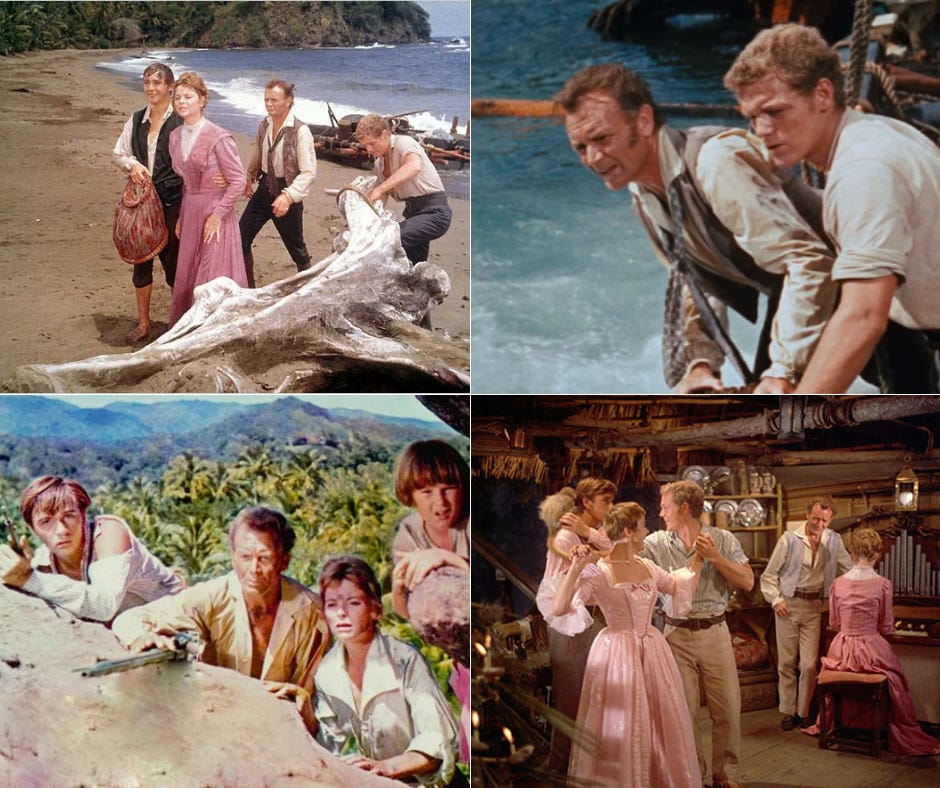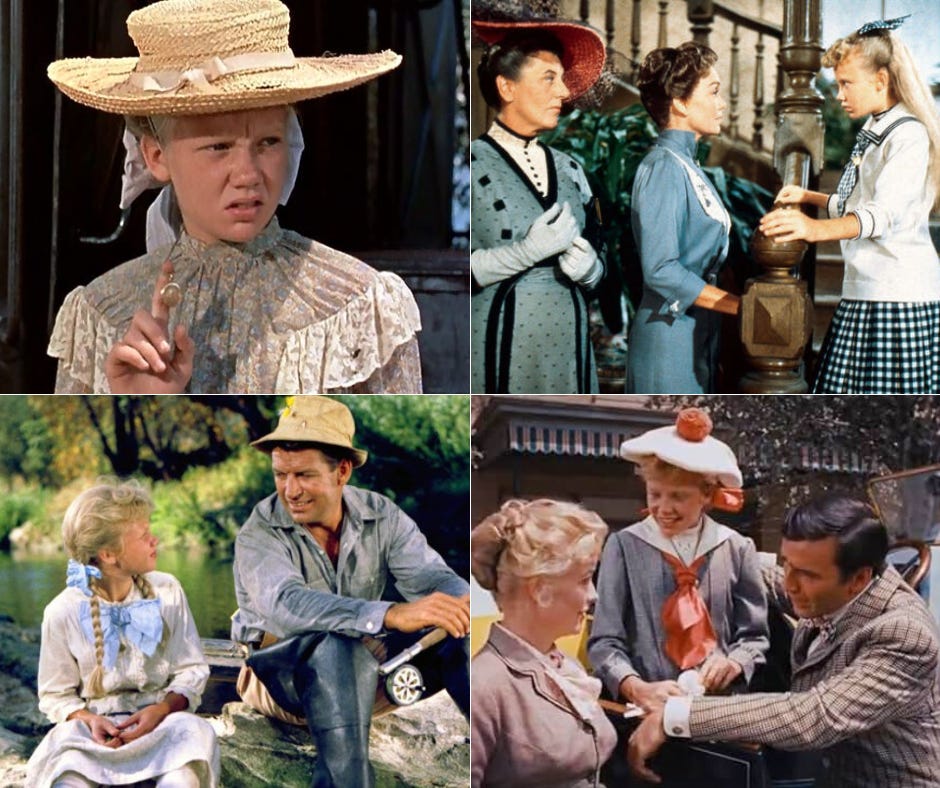Seven Classic Disney Live-Action Movies to Grow Up With
Family, fun, history, and nostalgia with old-time Disney
If the full post doesn’t show in your email, click “View entire message” to read the whole thing online.
When I was a child, watching TV was not an everyday thing for my siblings and I; it was more of a treat. We were allowed to watch a movie in the afternoon every now and then; we went through occasional stints of watching reruns of an old show on certain weekdays; but it would have been crazy to think of spending more than an hour or two out of a day in front of a screen, or even to do that multiple days running. Unless we happened to be sick, and comfort movies were in order.
Looking back, I think that was a very good way of doing things. Ice cream may be good, but ice cream all day or every day is neither healthy nor special any longer.
We didn’t watch indiscriminately, either. My mother was particular about our entertainment, making sure that it was not only wholesome but quality—not cheap fluff. We never got into “kids’ TV”—I watched a very little bit of Barney and Friends when small, but I don’t think I ever found it very intellectually challenging or engaging. I preferred classic movies! The Sound of Music was my favorite movie from around age five or even before. We had a little Shirley Temple movie collection; Roy Rogers came a bit later. We liked reruns of shows like Lassie or Little House on the Prairie—and of course, there was classic Disney. Not any and all Disney, though: we had a relatively small selection of animated favorites (Cinderella, Lady and the Tramp, Peter Pan, Bambi).
And then there were the live-action Disney classics.
A few months ago on Instagram, there was a trend going around where people were sharing the movies and shows that shaped their tastes and creativity in childhood—and sifting through the entertainment memories of my youth to participate, I realized just how foundational the old, classic, live-action Disney movies were to mine. And I ended up wanting to write a little retrospective on the handful of them that were the staples of our family VHS library (in the white clamshell cases with their distinctive plastic smell, or the cardboard ones, striped red-and-white or blue-and-white, which gradually disintegrated over the years), and which I remember most fondly to this day.
So Dear to My Heart (1948)
Based on the 1943 novel Midnight and Jeremiah by Sterling North
Whenever I mention this movie, it seems hardly anyone else has seen it—but it’s so lovely! The story of an orphan farm boy who sets his heart on entering his pet black sheep in the county fair, in order to prove to his strict but loving grandmother that the mischievous animal has value, it’s said to have been one of Walt Disney’s personal favorites, as it reminded him of his childhood in the rural Midwest. There are so many rich images of turn-of-the-century Americana, from the opening scene featuring a scrapbook tucked away in a farmhouse attic—the general store by the railroad tracks, the rail fences, the blacksmith shop, Granny’s weaving loom and prize quilts, square dance tunes on the gramophone.
I’ve always had a deep fondness for the American farm, which I like to think is partly my heritage—on one side of my family tree, nearly every branch were farmers right back to the early days of colonial New England—but also from the farm-themed picture books, stories, toys, and films I loved in childhood. So Dear To My Heart was always one of them.
I haven’t read the book it was based on, having heard from friends that it wasn’t as good as the movie—and curiously enough, North himself seemed to agree, releasing a second edition that altered some of the plot to follow the film script!
Old Yeller (1957)
Based on the 1956 novel by Fred Gipson
Old Yeller is really so much more than its infamous tearjerker reputation. It may be the most faithful book-to-screen adaptation Disney ever produced, and one of the most historically authentic-looking. It also happens to be underrated as a darn good western, its whole plot built around the demands of raising livestock and making a living off the land in frontier Texas—a rare western story that focuses on the experience of a frontier family rather than a lone drifter. As much a story of family ties and a boy growing into manhood as it is a dog story, it’s sometimes funny, sometimes touching, well-acted and beautifully filmed. Perhaps objectively Disney’s best.
(Addendum: the deservedly little-known 1963 sequel Savage Sam was, unfortunately, A Mistake. Lacking artistically in every area where Old Yeller excelled, it managed to turn what was a much more grim and brutal Gipson sequel novel into something cheesy and superficial.)
Swiss Family Robinson (1960)
Based on the 1812 novel by Johann David Wyss
At just over two hours, this is the Disney movie I remember as “the long one”—a little more of a special-occasion treat than the others, since it took up most of an afternoon. The approach to literary adaptation was quite different here: reportedly, screenwriter Lowell S. Hawley was told to take Johann David Wyss’ classic book (which is, frankly, mostly a chronicle of the shipwrecked family discovering new flora and fauna and building houses) and toss out what little plot it had, and simply invent the best shipwreck adventure story he could for the characters. Somewhat improbably, it works—perhaps because Hawley made quite a respectable attempt at grounding the characters in the context of the period when Wyss wrote.
The result is indeed a rollicking good adventure, with the plucky castaways facing some real perils with proper appreciation of the danger but with determined good spirits. (I defy you not to come away from the battle with the giant snake without “The knife! get the knife!” entering your family’s kitchen lexicon.) Looking back, it’s astonishing how rare many of its elements seem in this modern era: a happy mature married couple; a capable, respected, and affectionate father; a family who are at base fond of each other and pull together as a team, despite occasional inevitable spats.
Pollyanna (1960)
Based on the 1913 novel by Eleanor H. Porter
David Swift’s adaptation takes the basic core of Porter’s story, really quite a simple one—of an orphan girl with a determinedly positive outlook on life, taken in by her emotionally restrained aunt, who makes friends wherever she goes and ends up having a surprising impact on their lives—and expands it quite a bit, adding a few new characters, fleshing out others, and linking the whole thing together with an entirely new subplot involving small-town politics. And it works well. The subplot with everybody resenting the hellfire-and-damnation minister is rather tiresome, chiefly because, like most secular attempts to portray Christianity, it’s a false dichotomy (i.e., there’s nothing wrong with the Reverend’s doctrine on sin and hell, aside from his ranting delivery of it; he just does what no true minister of the Gospel does and stops short without preaching the message of repentance and redemption from said damnation).
But what I’ve always loved most about this movie is the sheer atmosphere of small-town, turn-of-the-century New England: its charity bazaars, hay rides, fishing holes, Main Streets; all the sets and automobiles and costumes that beautifully evoke the period.
Mary Poppins (1964)
Based on the 1943 novel by P.L. Travers
While my love for American history was well-rooted early in childhood, my Anglophile side developed a bit later—but I suspect Mary Poppins helped lay the foundations. To this day, I associate the misty opening credits with the memory of raspberry jelly on toast…because it was always my movie of choice in childhood when I was sick, set up on a bedsheet-covered couch in the living room with “jelly toast” as my invalid fare. I haven’t seen this movie in years—I don’t think I’ve ever actually seen it in widescreen (I lived in the days of pan-and-scan VHS!)—and it would be fun to revisit as an adult, and see just how many little familiarities with English culture, and how much fondness for the aura of Edwardian London, traces back here without my realizing it.
The Apple Dumpling Gang (1975)
Based on the 1971 novel by Jack M. Bickham
While the central thread in this comedy’s storyline is the roving gambler who suddenly finds himself saddled with three orphan children, all the best laughs come from the inimitable duo of Tim Conway and Don Knotts as the most hapless of would-be “outlaws,” who spend the entire film hilariously botching every attempt at stealing a fortune. You might just laugh till you can’t breathe at a few of their scenes in particular. It is also indubitably and whole-heartedly a western, producing comic twists on such staples as the hold-up, the saloon brawl, the poker game, the gold strike, the bank robbery, and the Great Chase Scene with affectionate abandon.
Bonus: the 1979 sequel The Apple Dumpling Gang Rides Again, while perhaps not quite as warm and artless as the original, does give us another whole round of priceless comic scenarios featuring Knotts and Conway, as the former outlaws run into mishap after mishap as they attempt to “reform.”
Davy Crockett, King of the Wild Frontier (1955)
Loosely based on true events
Okay, I admit: this was much more my brother’s favorite than it was mine. But I enjoyed it too, and it was certainly one of the staples in our little movie library. It was one more in a long line of books and movies that made me grow up thinking that 19th-century American history was something colorful and fun, not dry and remote; another bit of entertainment that helped fill out my vocabulary with both picturesque dialect and more erudite old-fashioned English.
Bonus: The 1956 “sequel” Davy Crockett and the River Pirates, a pure tall-tale adventure with Davy and friends involved in a boat race down the Mississippi River, is uproariously funny and just a hoot in general. My siblings and I were probably even more attached to this one—for a certain period, any fictional characters we happened to be enacting at the moment went sailing on keelboats.
It’s not at all hard to trace a path from these old movies to the tastes I developed and the kind of stories I would write in adulthood. Americana, adventure, family ties, humor, and a streak of English heritage—it’s all there.
It’s interesting to note that all of these movies were based on books (with the one exception, Davy Crockett, drawn from true events), though as one often sees with movie adaptations, there is a curious range of both source and approach: from obscure titles to beloved classics; from almost word-for-word faithfulness to totally jettisoning the original structure. But one thing they have in common, I notice in retrospect, is how family lies at the core of almost every one. Old Yeller and Swiss Family Robinson are about a family’s survival; Mary Poppins is about a family restored; and So Dear To My Heart, Pollyanna, and The Apple Dumpling Gang are all about orphans who have or find the love and security of family with relations or adoptive parents. In all of them family represents normalcy, warmth, happiness, something to be sought for if it doesn’t already exist.
I notice the same thing in a lot of older children’s literature. Not moral perfection; just a sense that there is an ideal of healthiness and rightness in ordinary human relationships, that it is good to celebrate it where it exists and to praise a striving towards it in our stories—instead of spending all our time commiserating over dysfunction.
Perhaps it’s that, combined with a sturdy artistic excellence, which makes these old family classics hold up so well.
And more to grow into…
As I mentioned before, my Anglophile streak didn’t really develop until a bit later, although I was well-grounded in English classics and children’s stories before I reached my teens. And it fell out that I also came later to some of Disney’s other live-action movies set in Britain, which don’t have the same “classic” status as Mary Poppins despite being much more historically authentic-looking. I’ve reviewed two favorites on my blog before:
Beyond the Cover Blogathon: Kidnapped (1960)
These days, one frequently sees popular historical novels based on the life of some real historical figure, or featuring real people from history as characters. One might say that Robert Louis Stevenson was ahead of the curve in this area. The plot of his 1886 novel
Greyfriars Bobby (1961)
Greyfriars Bobby (1961) is one of a string of Disney live-action movies from the early 1960s set in Europe (and one of a trio set in Scotland, along with Kidnapped and Rob Roy). Probably one of the least-known Disney movies from this era, it's based on the 1912 novel of the same name by Eleanor Atkinson—whom I did not realize, till I was writing this po…
If you enjoy The Second Sentence and you’d like to show appreciation without committing to a paid subscription, you could buy me a coffee or buy a book.














So many good ones! I love So Dear to My Heart too though I only came to it as an adult. Love Burl Ives. I also love all Haley Mills films from that era. Pollyanna, Thomasina, The Moon-Spinners, Parent-Trap. We had a box Haley Mills VHS set as kids and watched them on repeat. These are all so charming.
🎶 HE KILLED HIM A BAR WHEN HE WAS ONLY THREE 🎶 (this is what happens when you grow up with a brother named David and I can't control it)
Seriously though, the 1957 Johnny Tremain adaptation was a favorite in our house, in addition to The Swiss Family Robinson, Pollyanna, and Old Yeller. I wonder how many of these films have overlapping producers/directors (and WHY didn't they adapt Gone-Away Lake, huge missed opportunity). Quintessential summer!